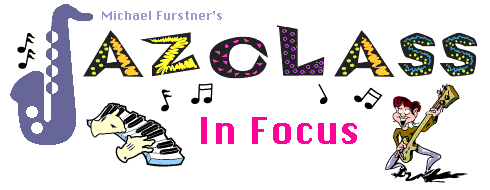
9. Syncopation - upbeats of 1+ and 3+
Contrary Motion - Syncopation Exercises - Song -
Practice Material
In Focus lessons online
Rhythm Class -
Jazz Theory - Music Notation - Jazclass Links
(Down - Top)
IF 9.1 - Contrary Motion
In 4/4 time there are 4 downbeats and therefore also 4 upbeats (or 'offbeat') in each bar.
As explained in Session 5 syncopations on the upbeats 2+ and 4+ have a strong forward motion effect on the music giving it energy and drive.
Syncopations on the upbeats 1+ and 3+ have the opposite effect. They hold up the flow of the music and appear to produce a backward motion. When both types of syncopations are combined in a phrase it feels to me like a long goods train starting off. When the train starts the carriages at the end move forwards and backwards a number of times (making much clanging noise) until all slack has gone out off the chain and the train moves smoothly forward.

Charlie Parker is probably the most creative improviser in the history of Jazz. His solos, transcribed and published in the Charlie Parker Omnibook are an excellent source for practice and research.For this session I did a small statistical study on the syncopations in three of his transcribed improvisations : 'Confirmation', 'Moose the Mooche' and 'Anthropology'.
The total sample covered 269 bars of music in which I counted 128 syncopations. By no means sufficient to be regarded as a reliable scientific study, but enough to give you a feel for Charlie Parker's approach to syncopation.
| Song
| Tempo
| Syncopation (%)
| Motion
| Frequency
|
| 1+
| 2+
| 3+
| 4+
| Forward
| Backward
|
| Confirmation
| 208
| 20
| 25
| 35
| 20
| 45%
| 55%
| 6-7 beats
|
| Moose the Mooche
| 224
| 23
| 37
| 20
| 20
| 57%
| 43%
| 6-7 beats
|
| Anthropology
| 300
| 18
| 32
| 14
| 36
| 68%
| 32%
| 15-16 beats
|
| Total
| -
| 20
| 30
| 26
| 24
| 54%
| 46%
| 8-9 beats
|
The above table brings out quite a few interesting points.

|
- Parker clearly plays syncopations on all four upbeats. Overall he shows a slight favour for forward motion syncopations, but the upbeats of 1+ and 3+ are also well covered in his improvisations.
- In each of the three songs he favours a different upbeat. It is 3+ in the first song, 2+ in the second, and 4+ in the last one. This perhaps reflects his (instinctive ?) unpredictability so typical of many aspects of his brilliant phrasing.
- Anthropology clearly stands out from the other two songs, perhaps because it was played at a much faster tempo (300 beats per minute). This solo strongly favours the forward motion syncopations (2+ and 4+), to give the solo extra momentum. Also the syncopations are much more widely spaced at almost 4 bars (15-16 beats) per syncopation.
- Parker's solos usually contains long strings of quavers and semiquavers. As a consequence the frequency of his syncopations (each 6-7 beats in the first two songs) is probably lower than that of a less fluent player.
|
(Down - Up - Top)
IF 9.2 - Syncopation Exercises
The following four exercises combine various syncopations.
Each exercise consists of two 2 bar segments which can be combined to form one 4 bar phrase.
Each exercise has a play-a-long track featuring dominant 7th chords around the Circle of Fifths. Each chord is played for 8 bars. The melody plays each 4 bar phrase twice using the one chord root tone, then moves onto the next chord root.
Audio IF 9.1

You can play these exercises in four different ways.
- Play chord root tones in unison with the demo.
- Play one of the other chord tones (3, 5 or b7) in harmony with the root on the demo.
- Play several chord tones or an arpeggio using the exercise rhythm pattern.
- Play several scale tones using the Mixolydian mode.
Audio IF 9.2

Audio IF 9.3

Audio IF 9.4

You can also use the blank play-a-long and combine 2 bar segments from two different exercises (like for example 1a with 2b).
(Down - Up - Top)
IF 9.3 - Song : Go for It
Go for It uses syncopations on different upbeats.
Time the grace notes so that the big note behind it always falls exactly on the downbeat.
melody

Improvise over the blues focusing on syncopation and using Mixolydian modes.
(Up - Top)
IF 9.3 - Practice Material
(Up - Top)
Copyright © 2001 - 2008 Michael Furstner (Jazclass). All rights reserved.
|